2022 ITG Conference Report - Day 3 - Thursday, June 2
The 46th Annual International Trumpet Guild Conference - San Antonio, Texas (USA)
Special Daily Report • Compiled by Peter Wood
Photos by Denny Schreffler, Josh Rzepka, Benjamin Lowe, Ryan Berndt, Jeff Grass, and Michael Anderson
Thursday, June 2, 2022
Click here for more photos from the ITG Conference
Allison McSwain warm-up session - Reconsidering the Warmup for Efficiency and Self-Awareness
Allison McSwain presented a wonderful and highly interactive morning warm-up class. She began by explaining the overarching goals of mindfulness and deliberate practicing through various mental and physical approaches to help create a greater sense of ease in playing. Her mental approach begins before every session with developing a clear purpose, expectation, and understanding of what defines a warmup. For her physical approach, McSwain uses the standard warm-up repertoire with unique additions, alterations, and expansions to better suit her specific needs for that day. She guided the class through chromatic expansions, scale patterns, articulation and lip-flexibility exercises that showcased her concepts. McSwain left the audience inspired to implement the concepts and tools that this class had to offer into their practice routine. (Maryna Pohlman)
Joe Cooper warm-up session - Your Warmup is Talking… Are You Listening?
Joe Cooper’s warm-up session was an excellent interactive clinic that included such important concepts as breathing, long tones, tonguing, flexibility, and air flow. The session began with everyone forming a large circle around the outer edge of the room, making sure everyone could see and hear each other and Dr. Cooper. He structured the session in a call-and-response style, encouraging students to follow his modeling while putting their ear to their own sound and response. Cooper used effective breathing exercises designed to maximize efficiency and then moved on to long tones, instructing everyone to achieve good response at a soft dynamic. His “active rest” exercises included having the group try silent finger practice, working through commonly difficult finger patterns. He offered some weighted tonguing ideas and “tongue twister” multiple-tonguing patterns in an effort to better train the tongue muscle. Overall, Joe Cooper provided everyone with an engaging and thoughtful warm-up session. (Scott Hagarty)
Ryan Gardner non-pro warm-up session - Breathe, Sing, Sound
Ryan Gardner’s morning warm-up session with the non-pro player community was well attended and brought a fresh perspective to fundamentals. Participants were introduced to stretches and breathing exercises at the beginning of the session, as well as mouthpiece and slurring exercises from the teachings of Boyde Hood. Attendees were guided towards finding their easiest, most beautiful tone, and the collective trumpet sound was impressive as the session progressed. The warmup also introduced improvisation as a part of a daily fundamental routine and provided new ideas on how to make fundamentals transferable to other areas of playing. (Julia Bell)
Brianne Borden - Morning Yoga for Musicians
Dr. Brianne Borden’s presentation provided the participants an excellent introduction to yoga and offered practical exercises for use in the future. She began by addressing posture, both sitting and standing, before going into some basic movement exercises. Improved posture, or foundational alignment, is one area she feels all musicians would find beneficial. She then led the group through stretches for the areas most injured by musicians - wrist, shoulders, and neck. Due to the repetitive nature of instrumental performance, musicians have one of the highest rates of injury of any profession. She guided the participants through a series of breathing exercises to aid in performance anxiety, including one called “Box (or Square) Breathing.” The session ended with a meditation exercise entitled “Body, Brain, and Heart.” Borden fielded questions from the participants and encouraged finding more information about yoga and musicians at her website (www.yogaforallmusicians.com). (Rich Tirk)
Ryan Gardner non-pro and comeback players masterclass - Enjoy and Improve
With a warm, welcoming approach, Dr. Ryan Gardner invited attendees of his morning masterclass to play for him. He offered that it could be a scale, warmup, etude, or anything they wanted to play. With each of the volunteers, he exemplified the qualities that we know make him an impactful teacher. In his teaching, he led with questions and curiosity with an emphasis on embracing the positives. Within that positive framework, he still caught on to opportunities for improvement and addressed them immediately. Each of the players demonstrated significant improvement in just a short time in working with Gardner. He engaged not only the learners, but also the entire audience so that each person was able to walk away feeling inspired and empowered. (Brianne Borden)
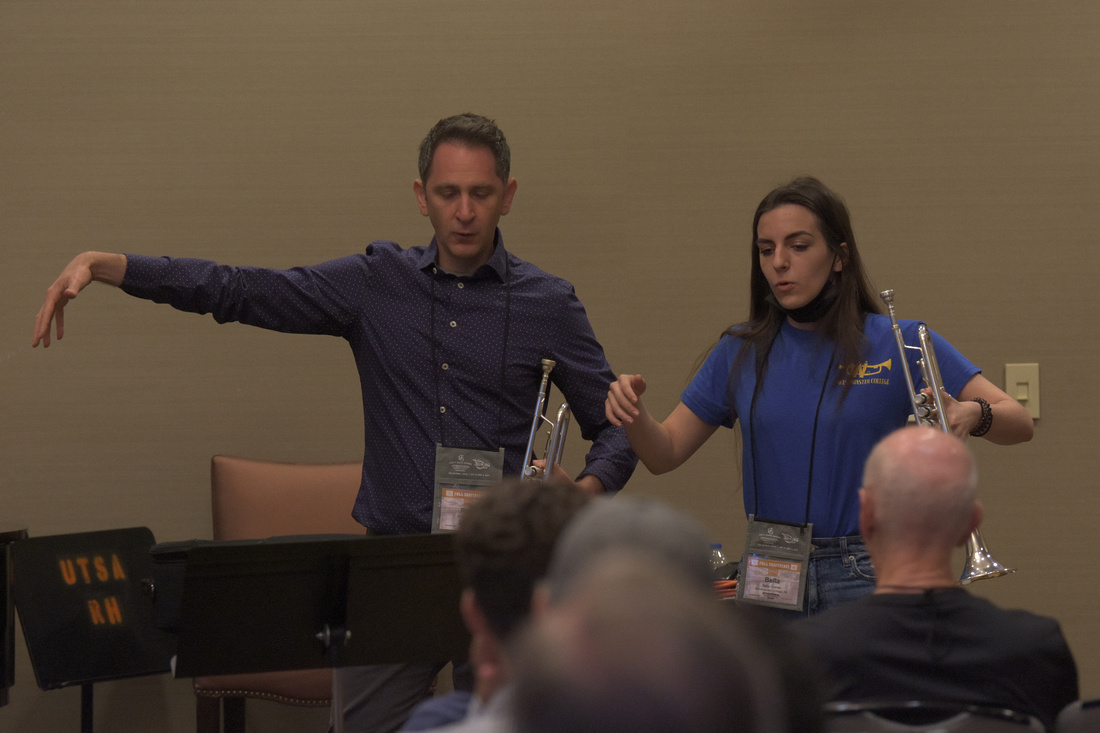

John Kilgore lecture - From New Jersey to Cincinnati: The Life and Career of Classical Trumpeter Philip Collins
John Kilgore shared an informative presentation on trumpeter Philip Collins, including biographical and professional information from the musician’s life and career. Because Kilgore chose to research a living legend, the session was chock-full of details and first-hand memories from Collins himself. In addition to biographical information, the presentation included many recording examples, showcasing the range and depth of the 100+ albums of which Collins was a part. The research that led to this enlightening session is an important project that will preserve the life and memory of an incredibly talented, prolific, and influential musician. (Jena Vangjel)
Betty Scott clinic - Emotional Freedom Techniques (EFT) for Brass Players
Brass players are often subjected to physical and mental traumas. Dr. Betty Scott presented Emotional Freedom Techniques (EFT) as an avenue to ease those traumas and improve performance. EFT addresses negative emotions that can cause a disruption to the body’s energy system. Scott stated that people typically have around 80,000 thoughts throughout each day, 30,000 of which are negative. EFT begins by first addressing a negative trauma (mental or physical) and feeling the emotion associated with it. A sequence of tapping specific points of the face and body, along with positive self-talk, accepting yourself and the trauma, help remove some of the anxiety associated with that trauma. EFT may be a solution for musicians to cope with negative or anxious thoughts and even help with physical ailments due to playing brass instruments. (Spencer Brand)
Benjamin Hay and Andrew Cheetham clinic - Pedagogy Behind Duets: Improving Practice and Performance Together
Drs. Benjamin Hay and Andrew Cheetham gave an insightful presentation on how to utilize duets to address pedagogical topics and encourage student engagement. They detailed how duets can help students improve teamwork; match sounds, styles, and articulation; and become adaptable as ensemble players. The audience was kept engaged through duet demonstrations in a variety of styles: classical, orchestral, and jazz. The players performed the duets first with common pitfalls, such as intonation, balance, and releases. Those in attendance were asked to identify areas of concern. Hay then gave solutions for teachers to help students improve and performed again. Cheetham concluded the presentation with a discussion of how assigning duets to students can help jumpstart their musical development through learning peer professionalism, mentorship, and motivation through studio performances. (Kyle Millsap)
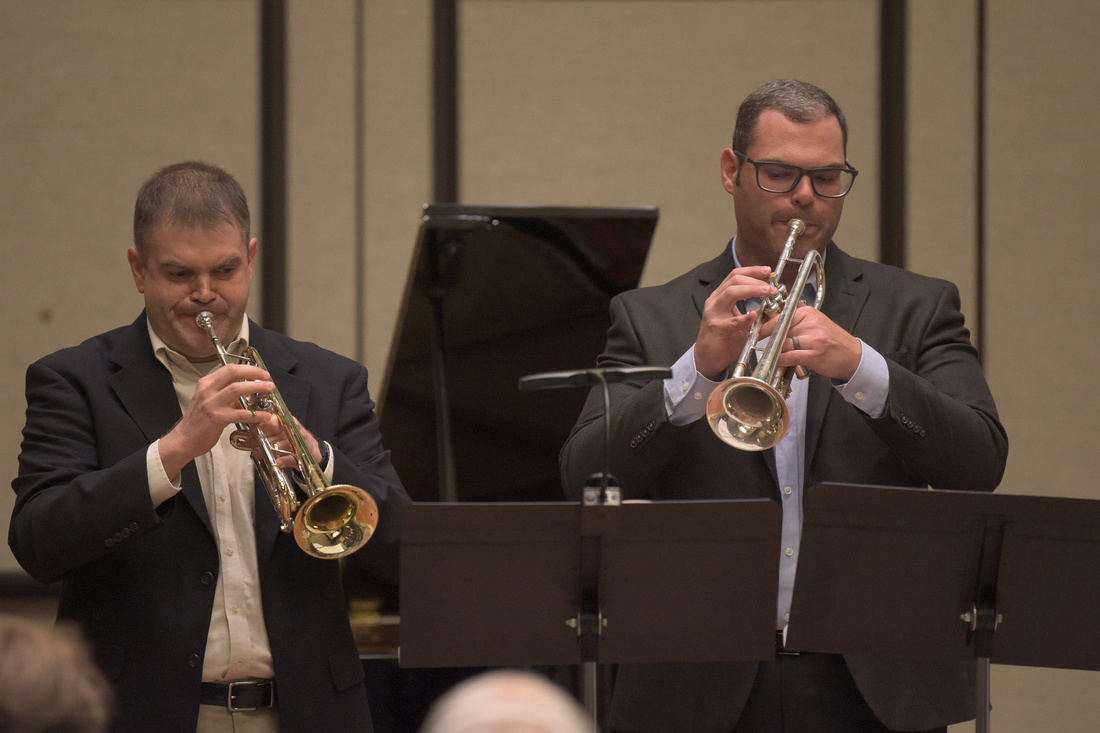

Solo Competition Finals
In front of a full room and a prestigious panel of judges, three young trumpet players put on a true tour de force for the final round of ITG’s solo competition. Introduced by Solo Competition Chair Jean Laurenz, DoYoung Baek, from South Korea, played first. At just fifteen years old, he possesses a sound and technique that brought a sense of wonderment over the audience. During his performance, there were consistently audible reactions to the most difficult passages, especially as he performed Desenclos’ Incantation, Threné, et Danse. Leaving the audience wondering how anyone could follow such a performance, Rui Almeida from Portugal entered the stage. Well put together and smooth mannered, Almeida continued providing the sense of awe the audience had been experiencing thus far. On William Perry’s Trumpet Concerto, he displayed beautiful lyricism and mature musicianship. Capping off three showcases of incredibly capable and skilled trumpet players, Diogo Costa’s particularly unassuming body language was contrasted by an absolutely electrifying performance of Stan Friedman’s Solus. With these young performers pushing the boundaries of what can be accomplished, this was one performance that was not to be missed. (Nathan Shadix)

 New Works Recital II
New Works Recital II
Chloe Swindler is an up-and-coming young artist, leading the way for her generation of trumpet players, and her performance of the first movement of Cooper Wood’s Sonata for Trumpet and Piano was an extraordinary example of her musical leadership. While one might expect newer repertoire to sound post-tonal or experimental, the work was easily accessible to all members of the audience. Miriam Hickman’s lively performance at the piano made the piece an enjoyable and relaxing listening experience. Swindler performed with a brilliance to her sound and made a technically challenging work sound truly effortless.
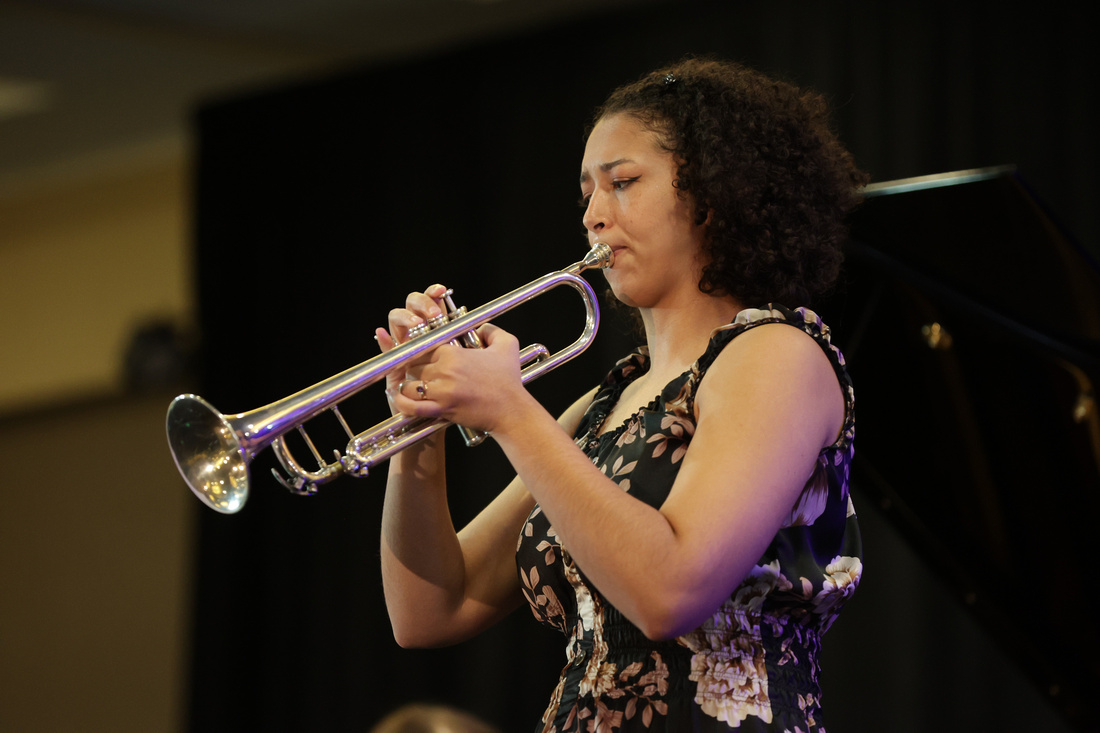

The first movement of Stanley Curtis’s Epiphany Window: Night Passages, promises to evoke scenes of a sunset giving way to night as the moon and stars come out, and the composer’s own performance of the piece held up to that promise. Curtis’s lyrical lines and rich upper register on flugelhorn gave the piece an air of solemnity and contemplation. The performance was a beautiful display of the sonic capabilities of the flugelhorn.
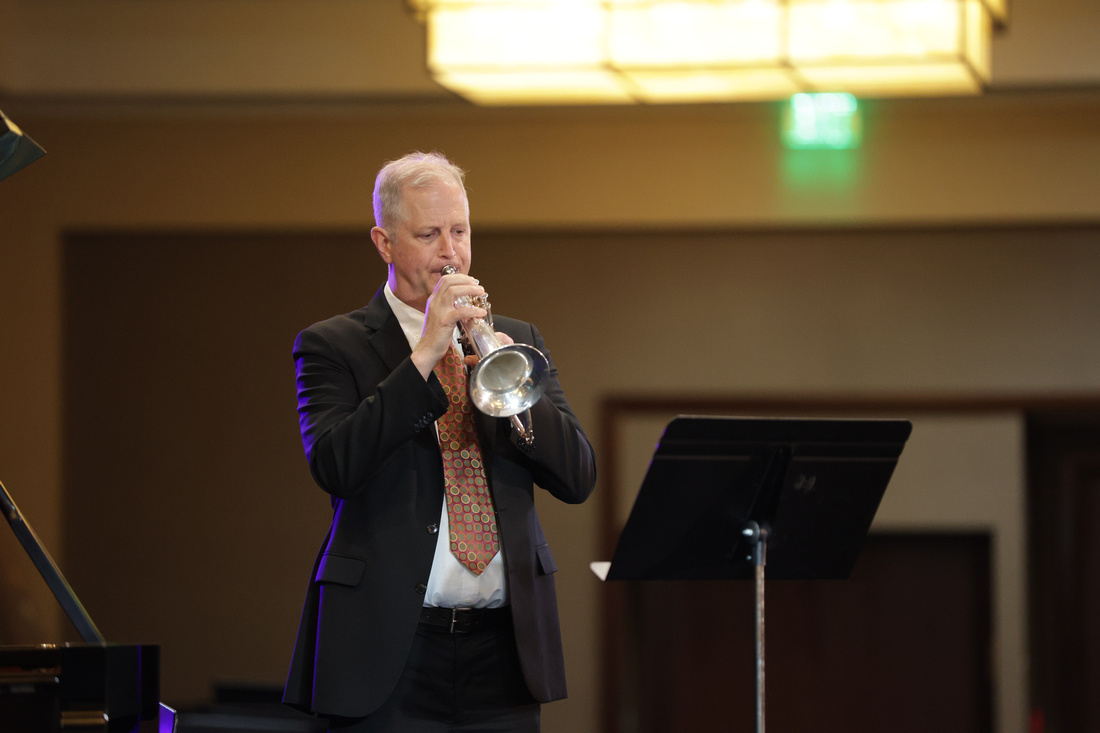

One might assume a work titled Andante & Scherzo to be from the European tradition, but Juan Carlos Valencia Ramos’s composition of that title showcases a Columbian interpretation of the form, and Columbian trumpeter Juan Avendaño’s performance demonstrated that interpretation beautifully. Avendaño was able to achieve incredible dynamic control while exploring different articulation styles that gave an exciting texture to the musical lines. The most incredible aspect of Avendaño’s performance was his ability to execute demanding technical passages while managing to avoid overtaking the sweeping piano lines.
Cody Ortz’s programmatic work titled …And Streetlights Will Fade tells the story of a man slipping into madness, and Timothy Winfield’s performance of the work placed the listeners right into that musical story. The angularity of the line, the short phrases in the middle lyrical section, and the clear pop to Winfield’s articulation painted a complex tonal picture for the audience. The use of different mutes for character changes was extremely effective in portraying the different sides of the story’s main character.
As soon as Brandon Dicks walked on stage, the audience knew they were in for a treat. The performer exuded confidence and conviction before he even brought the trumpet to his face. Dicks’s performance of Dalian Bryan’s …Another Tango showcased his technical capabilities, and the Latin flair he achieved in his sound highlighted the composer’s experience with the titular dance style. While the style of the work stays in touch with its roots, the rhythmic elements are innovative and progressive - a fabulous way to end a program of contemporary repertoire. (Christopher Luebke-Brown)
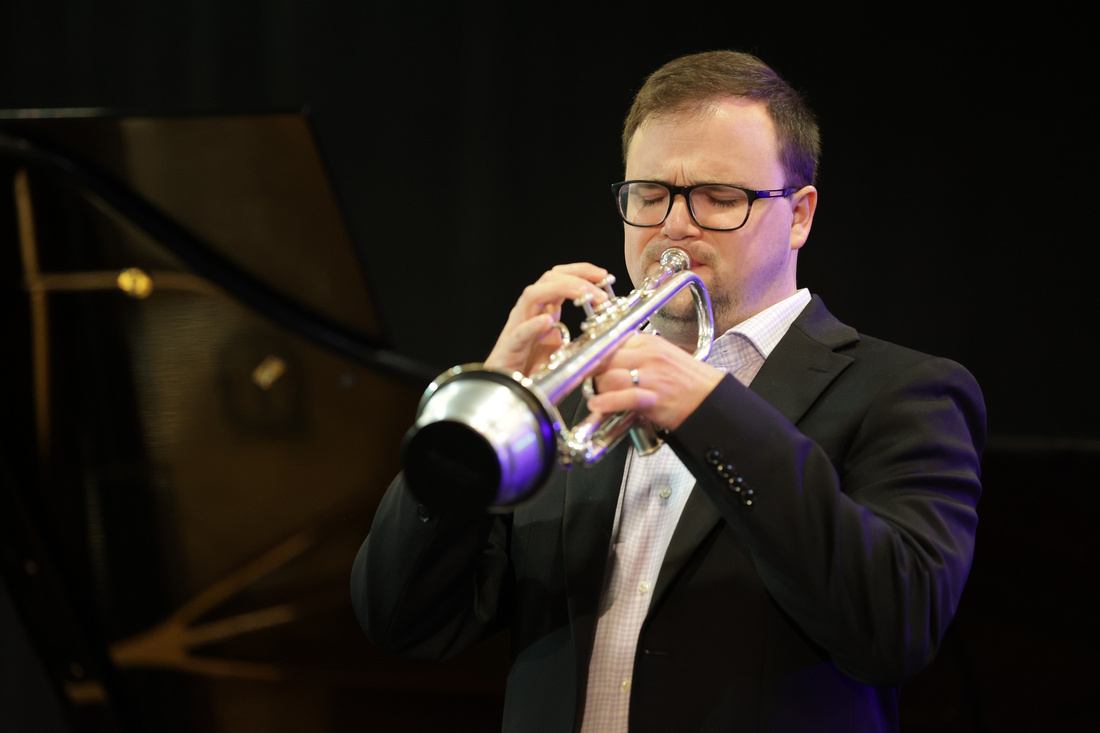

Larry Powell and Fred Sienkiewicz clinic - Suzuki Trumpet is Here!
Larry Powell and Fred Sienkiewicz opened their presentation with an important maxim from Shinichi Suzuki’s famous pedagogy - “Every child can.” This was their inspiration for becoming some of the early pioneers of the Suzuki method for trumpet. Testimonial videos of children learning to play from a very young age peppered the session and helped to make a serious case for using this method. The presenters maintained an open dialogue with the audience throughout, fielding questions about which types of trumpets to start students on, how to incorporate the method with older students, and the viability of implementing the method alongside traditional music education in the schools. Overall, Powell and Sienkiewicz made a compelling case for the Suzuki method and its benefits to trumpeters. (Eli Denecke)
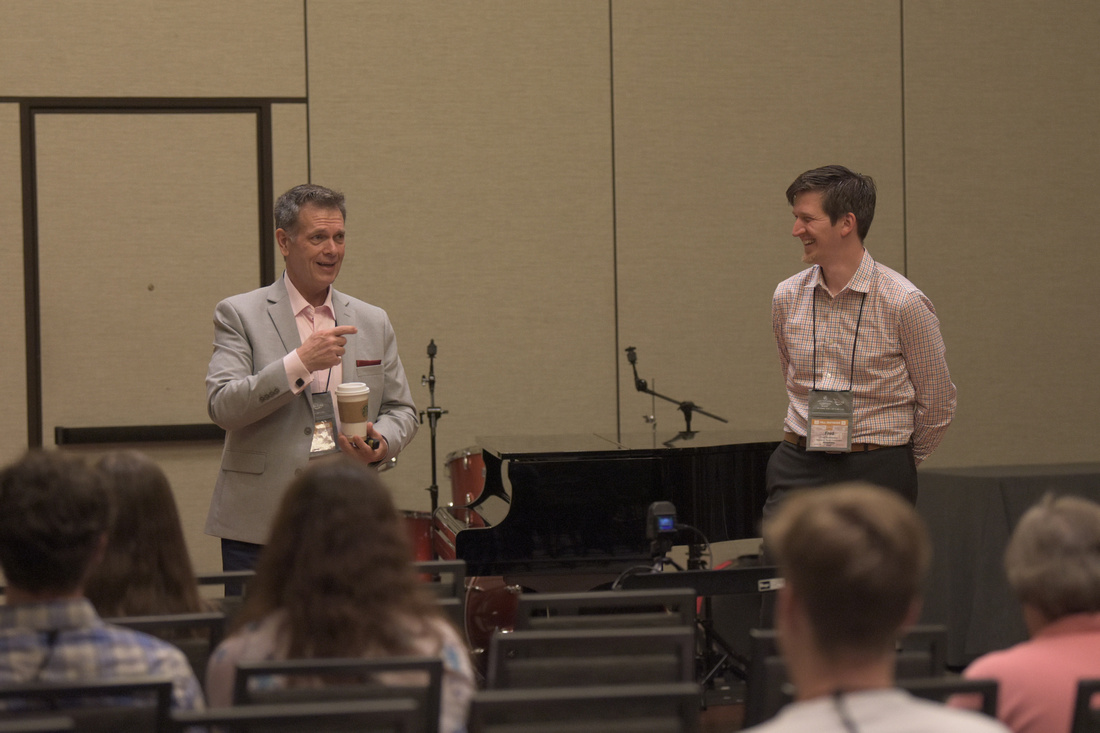

Phil Snedecor clinic - Breaking the Mystique of “Wind & Song”
Beginning with a brilliant performance of his own composition on piccolo trumpet, Phil Snedecor wowed the attendees of his afternoon masterclass with his seamless transitions between impressive playing and impactful teaching. In his teaching, he exemplified authenticity and vulnerability in sharing his (at times tumultuous) journey to his success today. He attributed some of this success to working with Arnold Jacobs, however he was very clear to differentiate between the differences of Jacobs’s pedagogy on tuba versus how it could apply to the trumpet. This hour of teaching interspersed with playing kept the attendees engaged, excited, and ready to try new approaches to air, singing, and applying these concepts to the trumpet. (Brianne Borden)
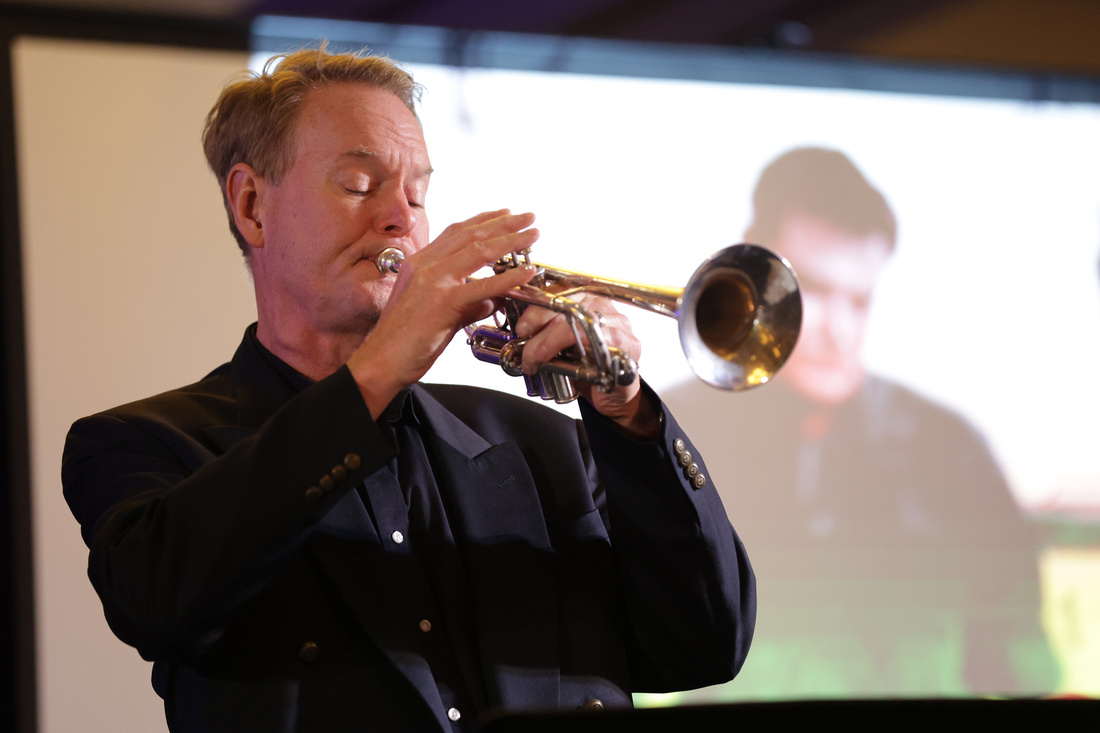

Friedemann Immer and Robert Apple lecture recital - News About the Keyed Trumpet and New Music for the Keyed Trumpet
Friedemann Immer and Robert Apple presented a lecture on the history and music written for the keyed trumpet. Immer discussed the history of the keyed trumpet, the tuning mechanism, and the distinction between the many keyed trumpets. Immer displayed two keyed trumpets by demonstrating the difficulties in the tuning and fingering system. Apple’s portion of the lecture focused primarily on the repertoire written for the keyed trumpet. Contrary to popular belief, Apple’s research displayed a large volume of works written for the keyed trumpet. He talked about method books, chamber works, and solo works that have been newly rediscovered. Overall, Friedemann Immer and Robert Apple’s session was an informative overview of the keyed trumpet and how it functions, as well as the music written for it. This lecture recognized the importance of the keyed trumpet as a significant component in music history. (Javian Brabham)
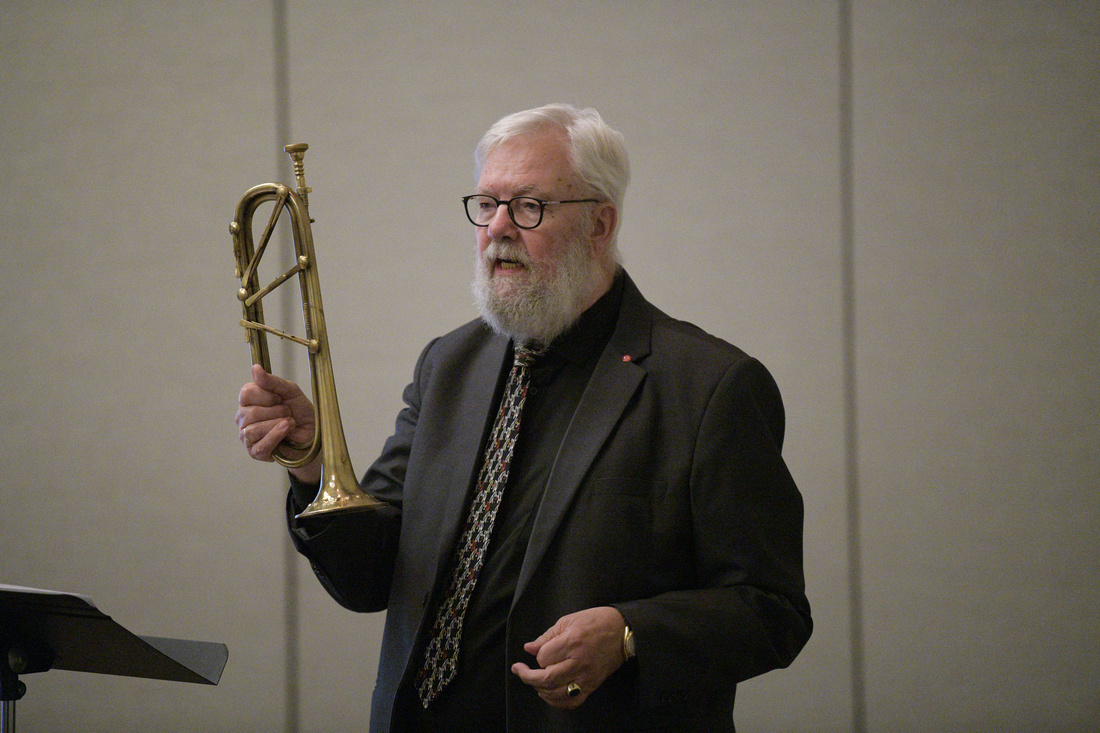

Ellsworth Smith Competition winner’s recital - Aleksander Kobus
Aleksander Kobus presented a spectacular recital featuring the works of both known and less-played pieces for trumpet and piano. Kobus opened with a wonderfully acrobatic performance of Joseph Turrin’s Caprice. Kobus showed amazing artistry through the lyrical and technical passages throughout the work. Kobus continued with Halsey Stevens’s Sonata for Trumpet and Piano. His diverse color and depth of sound was a treat for listeners. Kobus then dazzled the audience with his intervallic precision in Krzysztof Penderecki’s Concerto for Trumpet. He presented Miroslaw Gąsieniec’s beautiful Elegy for Trumpet and Piano. This work showcased Kobus’s flugelhorn artistry through beautiful sweeping lines that soared over the driving piano melody. Kobus closed his recital with Fryderyk Chopin’s Waltz Op. 34, No. 2, arranged for trumpet and piano. He mesmerized the audience with his warm and effortless flugelhorn playing, and his artistry was a true gift to listeners. (James Peyden Shelton)
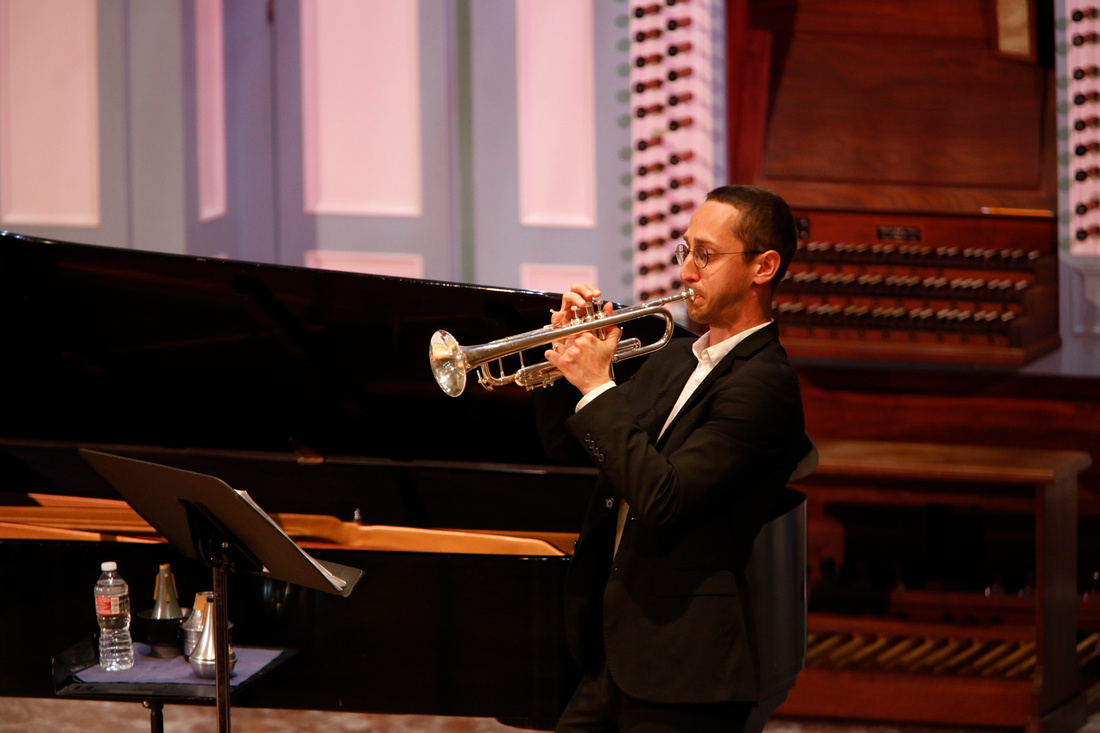
 Caruso Competition winner’s recital: David Adewumi
Caruso Competition winner’s recital: David Adewumi
David Adewumi was the winner of the 2019 ITG Carmine Caruso competition - and for good reason, despite his questioning whether music is even a competitive arena. While this is a healthy debate, one can obviously see why he would be awarded for his achievements. As Adewumi walked onto the stage, the members of the rhythm section - Mike Frank on piano, Peter Paulsen on bass, and Larry Marshall on drums - also walked onto the stage and sat at their respective instruments. The atmosphere was electric, and the cool licks and harmonies gripped the audience’s attention. With very tasteful and interesting solos from all parties involved, some of Adewumi’s compositions were featured, ranging from quiet, ethereal sounds in Dolphin Dance to a ballad called Old Folks with a blues sound, as well as some very engaging melodies in Ventilation, which he attributed to beauty in the mundane and beauty in the ugly. (Nathan Shadix)
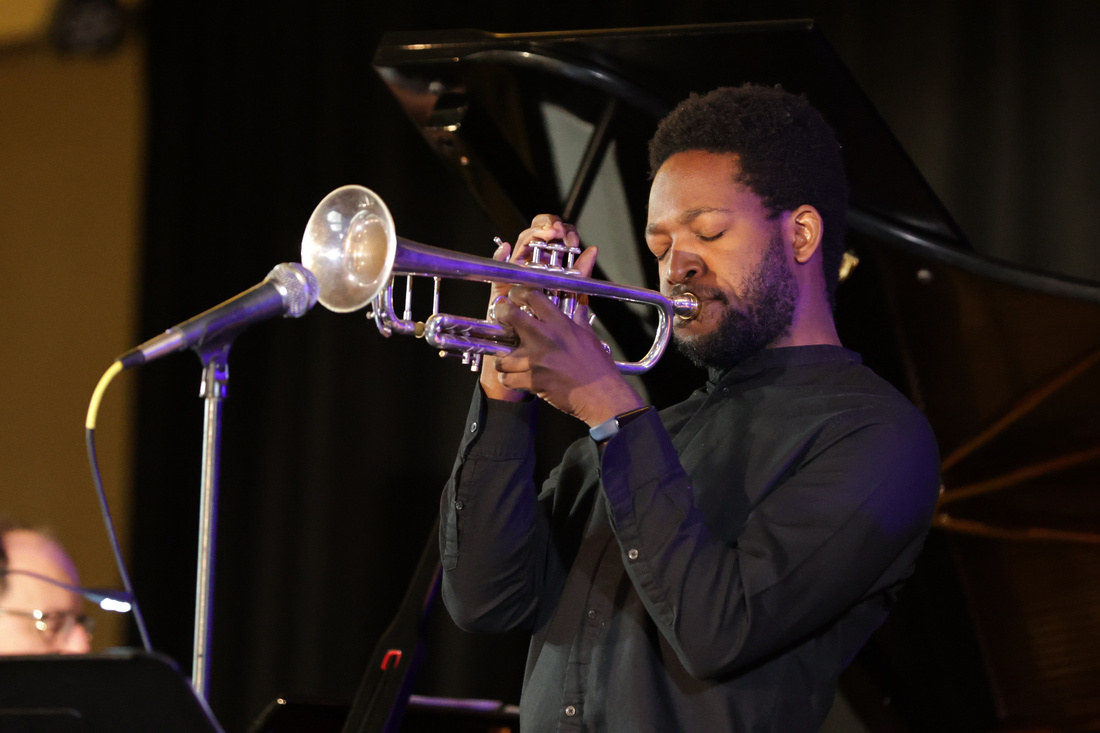
 Stephen Burns recital - The French Connection: A Celebration of Our Lineage
Stephen Burns recital - The French Connection: A Celebration of Our Lineage
Stephen Burns and Rebecca Wilt captivated their audience with a true display of artistry in this highly engaging performance. Burns opened by leading the audience through a mindfulness activity that encouraged them to reflect on their own lineage. Mentioning that all modern trumpeters can trace their lineage back through Arban and Dauverné was an excellent segue into his opener, Jolivet’s Concertino. Each work in the concert was performed as a reflection of some of his most influential mentors. They performed with true virtuosity and elegance on staples from the French repertoire like Enesco and Ibert, showing the strong influence of Pierre Thibaud and Roger Voisin. Elegy for Mundy, a piece that Burns commissioned in memory of his teacher, Armando Ghitalla, was a wonderful addition to the program, as was Close Fight for trumpet, electronics, and video. Burns closed with his own exciting adaptation of “A Julia de Burgos” from Bernstein’s song cycle. The level of mastery and subtle nuance displayed throughout the performance made it evident that he is a strong contributor to our trumpet lineage. (Nick Volz)
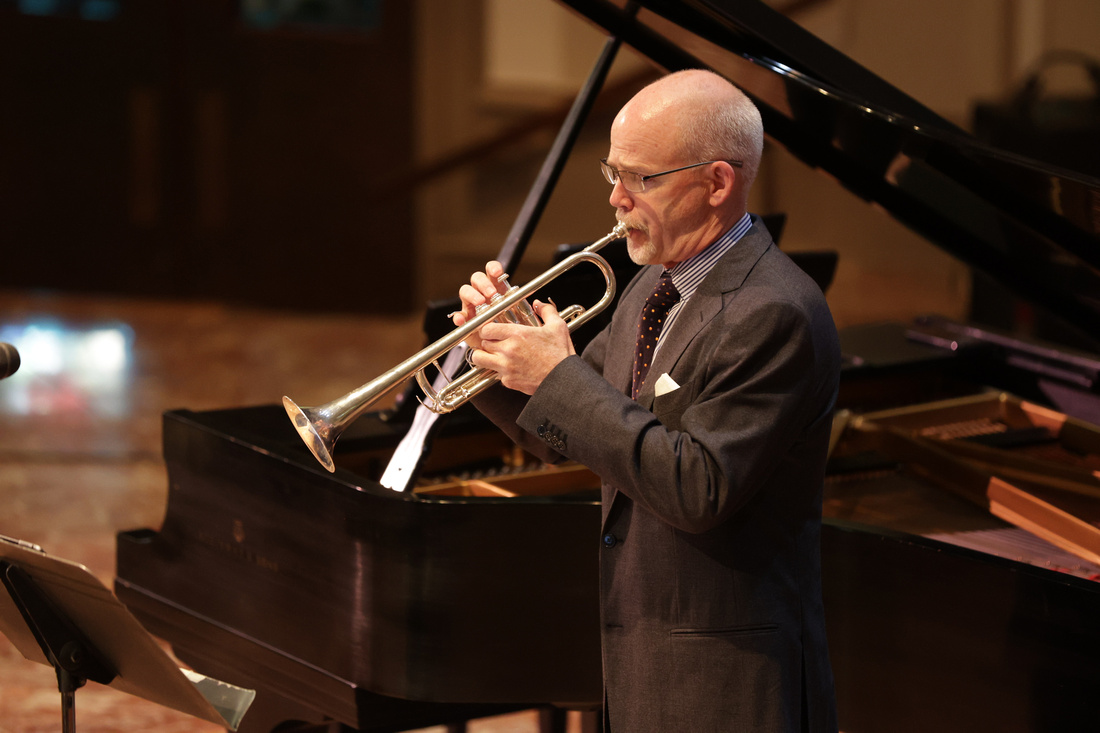

Trumpet Ensemble Reading Session
Conference participants had the opportunity to read through trumpet ensemble music, which was graciously provided by Triplo Press. The mass trumpet ensemble, led by Aaron Witek and James Olcott, played arrangements for ensembles as small as 8 players to as large as 24 players. They played pieces of various styles, ranging from J.S. Bach to Gustav Holst. The ensemble closed out the enjoyable session with a rousing rendition of John Williams’s Star Wars. (Nathalie Mejia)
Jonathan Barnes clinic - Advanced Melodic and Rhythmic Concepts for Improvisors
US Navy Band Commodores trumpeter Jonathan Barnes’s clinic focused on using upper-level theoretical concepts in a musical way. Barnes advocated beginning by learning all major and melodic minor modes and then playing scale degrees 1-3-4-5-1 in each key. He then demonstrated creating upper structure triads from different pitches in the major scale. To think musically, he related this to voice leading between chords and demonstrated connecting outlined chords to create a cohesive melodic line. To add rhythmic complexity to solos, Barnes played examples of melodic patterns with five, six, or seven notes. When playing in 4/4 time, these patterns shift the metric pulse and surprise the audience. Throughout the presentation, Barnes continuously stressed the importance of trusting your own ear and using trial and error when experimenting with new sonorities. (Marisa Youngs)
Juan Avendaño recital - Colombian Music by Colombian Composers
Recognizing the relative dearth of music for trumpet by Colombian composers, Juan Avendaño set out to commission and record new music from his homeland. Where only twenty years ago there was barely a handful of published works, we now have over fifty in circulation, half of which Avendaño has performed or premiered. Avendaño released his first CD in 2015, with plans to record a second in the near future. The eight selections on this concert presented a variety of styles and technical challenges, all adeptly handled by Avendaño and pianist Miriam Hickman. Of particular note was Jorge Humberto Pinzón’s Evocation, an episodic work that refused to settle into a style or harmonic language for very long, but was highly engaging. Marcos Galindo’s Pieza de Concurso Colombiana was selected for the final round of the Philharmonic Orchestra of Bogata’s XIV National Competition of Musical Interpretation in 2012. In the tradition of the European contest solos, it includes significant lyrical and technical requirements wrapped in nationalistic styles - in this case, elements from Bambuco, Pasillo, and Fandango. (Daniel Kelly)
Orchestral Excerpts Competition Finals
The ITG Orchestral Excerpts competition was a highlight of Thursday afternoon. Contestants Michael Winkler (University of Colorado-Boulder), Noah Mennega (University of Colorado-Boulder), and Victor Pires (Georgia State University) each played skillfully, showing considerable understanding of the orchestral works that were represented. All three played Mussorgsky’s Pictures at an Exhibition, Rimsky Korsakov’s Scheherazade, Shostakovich’s Piano Concerto, Stravinsky’s Petrushka, Gershwin’s American in Paris, and Bruckner’s Symphony No. 7. Winkler was the first to perform and began with a strong, bold opening in Pictures, and a great double tongue in Scheherazade. He did a good job of conveying different styles and musical ideas in the Gershwin and Shostakovich and finished with a beautiful and brilliant high note on the Bruckner excerpt. Noah Mennega was next and played with a clean, pure sound, demonstrating excellent rhythm and pitch. In the Gershwin, he had a beautiful vibrato that tastefully matched the style of the excerpt and again showed a good contrast between the different excerpts. Victor Pires was the last of the three contestants and played with a powerful sound that filled the room. He also made nice adjustments in tone and color between the various excerpts and demonstrated a thorough understanding of each orchestral work. He displayed fantastic dynamic contrast when he played Petrushka's Ballerina Dance, and his interpretation of Bruckner was spot on. All three played extremely well, and the audience thoroughly enjoyed the competition. (Spencer Wallin)
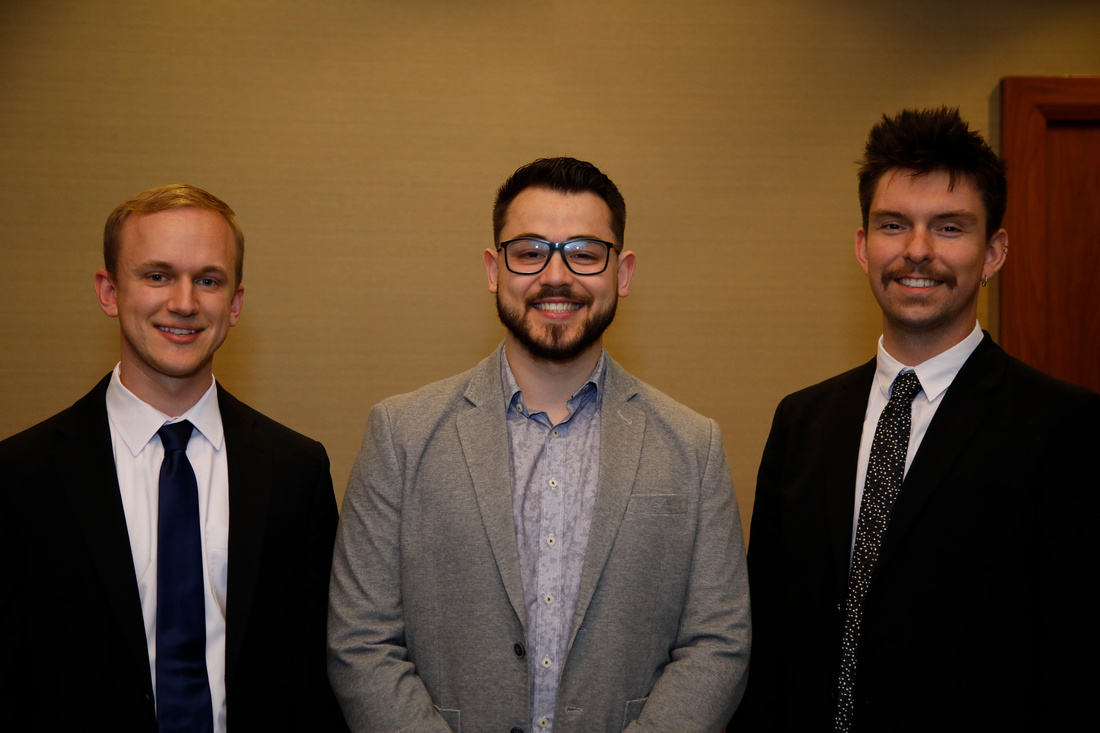

ITG General Members Meeting
With roughly 30 members in attendance, the ITG General Meeting focused on the future of ITG. President Jason Bergman outlined items from the recent board meeting. Vice President Ryan Gardner discussed student engagement, specifically bringing more students to ITG Conferences. One significant development includes Conference competitions, which will now each include a live semi-final round of fifteen students in each competition. Future Conferences will also host a new chamber music competition with broad guidelines to help bring in more students. The organization also wants to focus efforts internationally and plans to create two new smaller regional conferences each year - one abroad and one in another region of the United States. Dixie Burress, ITG Treasurer, gave a brief overview of the organization’s finances and membership. Conference Coordinator JC Dobrzelewski offered information about future Conferences, and the board fielded questions from members about the organization. (Marisa Youngs)
Evening Concert: US Army Brass Quintet
The United States Army Band “Pershing’s Own” Brass Quintet presented a truly magical performance that gave the audience a sampling of nearly every genre of music. The concert opened with a world-premiere fanfare by Phil Snedecor that literally had the audience’s heads turning. They then presented a beautiful arrangement of the Overture and Allegro from Handel’s Music for the Royal Fireworks, arranged by MSG C.J. Seipp. They quickly transitioned into an virtuosic rendition of Vivaldi’s L’estro Armonico that showcased SFC Kevin Gebo on piccolo trumpet while inviting renowned soloist Jens Lindemann to join the ensemble to complete the accompanying quintet while Gebo performed his sparkling acrobatic solo feature. Highlighting the unit’s primary mission of providing honor services for fallen soldiers and veterans at Arlington Cemetery, the quintet performed a beautiful and solemn rendition of Amazing Grace and Bridge Over Troubled Water that was paired with touching video footage of many of the ceremonial services that “Pershing’s Own” is tasked to provide. Trombonist SSG Greg Hammond then took center stage to perform Eric Cook’s Bolivar. This Latin-inspired work allowed the trombone to shine through dazzling solo lines with Spanish flair. The ensemble then shifted genres once again as they performed a piece that was arranged specifically for the funeral of former United States Secretary of State Colin Powell, which happened to be Abba’s famous song “Dancing Queen.” Trumpeter José Sibaja joined the ensemble to provide support with his beautiful shaker skills.
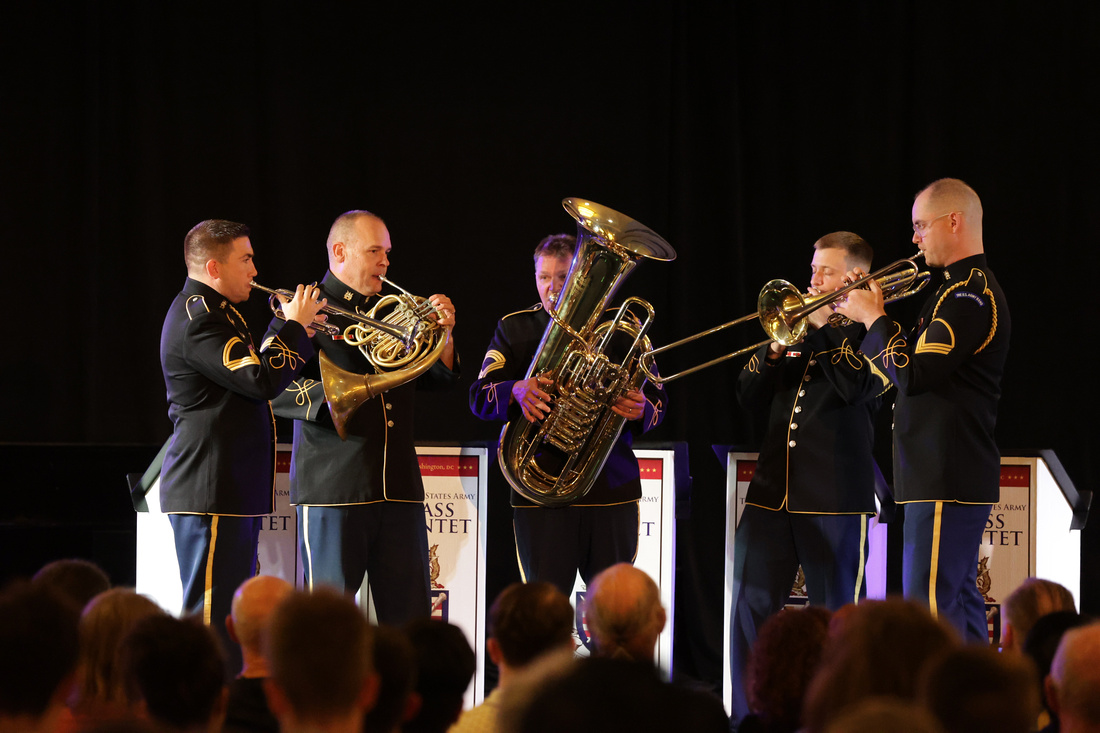

After a short ceremony in which the winners of the solo and orchestral excerpt competition were announced, as well as a presentation of a plaque to Grant Peters in honor of his work as ITG president for the last two years during the COVID crisis, the concert continued with the fifth movement of Enrique Crespo’s Suite Americana. The group’s powerful sound quickly pulled the audience back into the concert with their thrilling flourishes and fiery articulated figures. Providing yet another Classical staple to the plethora of works on the concert, the “Pershing’s Own” Brass Quintet transitioned into a spectacular performance of Mozart’s Marriage of Figaro. This arrangement showcased the technical precision and virtuosity of nearly every member of the ensemble through quick scalar passages and layered rhythmic complexity. They then honored those serving in the US Armed Forces both at home and abroad with a touching arrangement of America the Beautiful and then closed the concert with a piece by Peter Meechan’s Song of Hope, which featured a jaw-dropping list of trumpet legends including Peter Bond, Phil Snedecor, Tom Rolfs, Mark Gould, and José Sibaja - all under the direction of Dr. Jerry Junkin (director of bands at the University of Texas – Austin). The final piece served as a beautiful memorial to Ryan Anthony and his tremendous work of lifting spirits through his music and his tireless dedication to helping others in their battles with cancer through his organization, Cancer Blows. This is truly a concert that this reporter will never forget. (James Peyden Shelton)
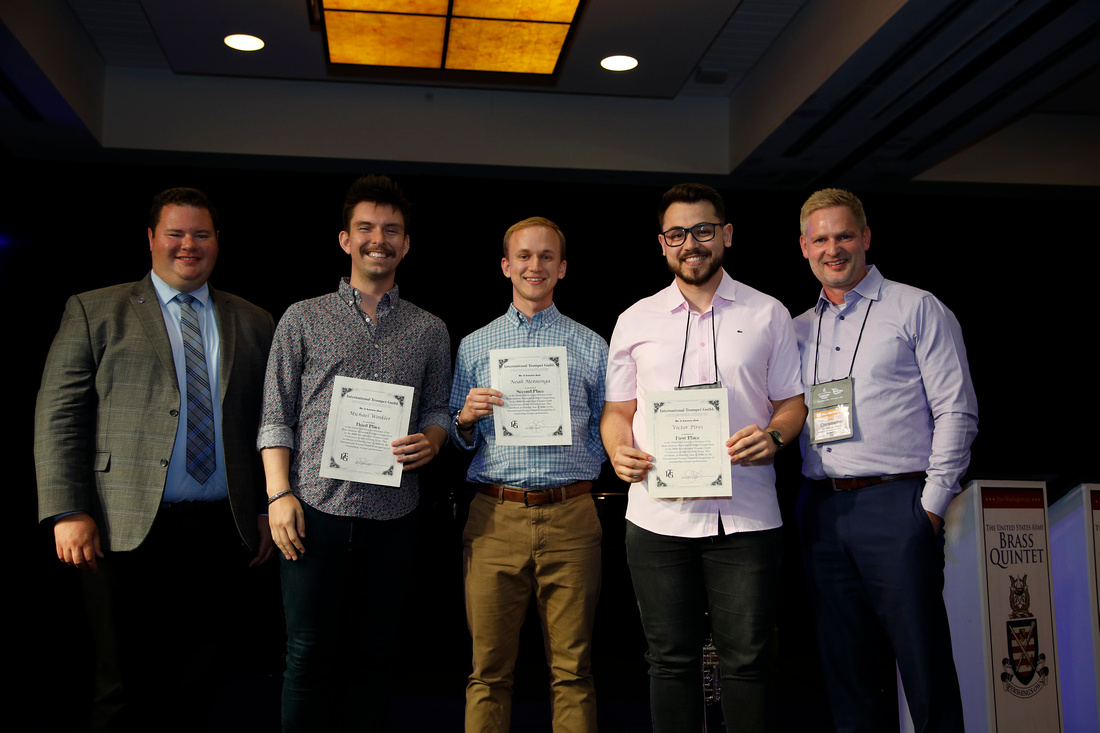

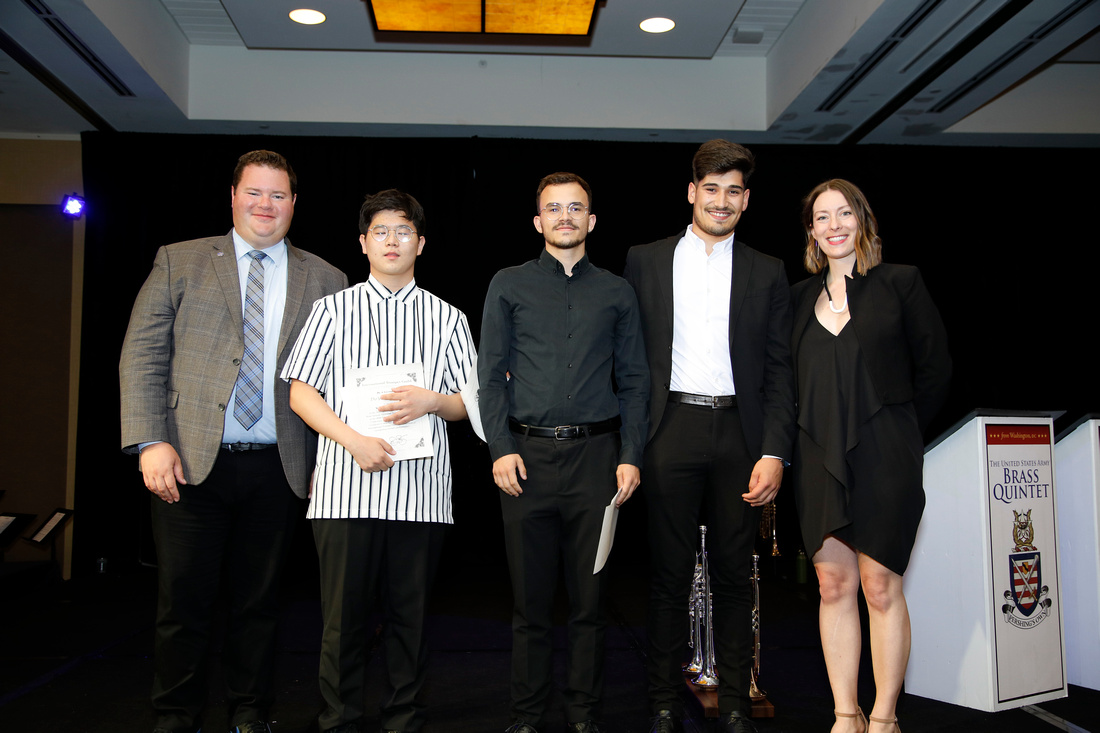

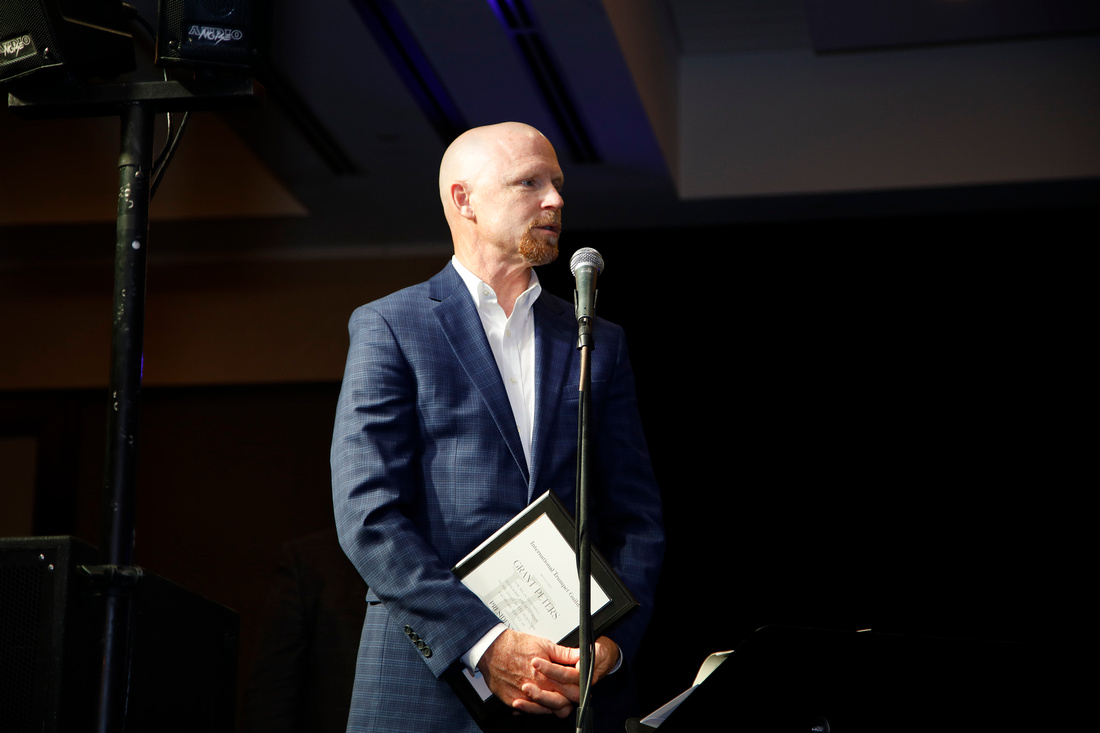

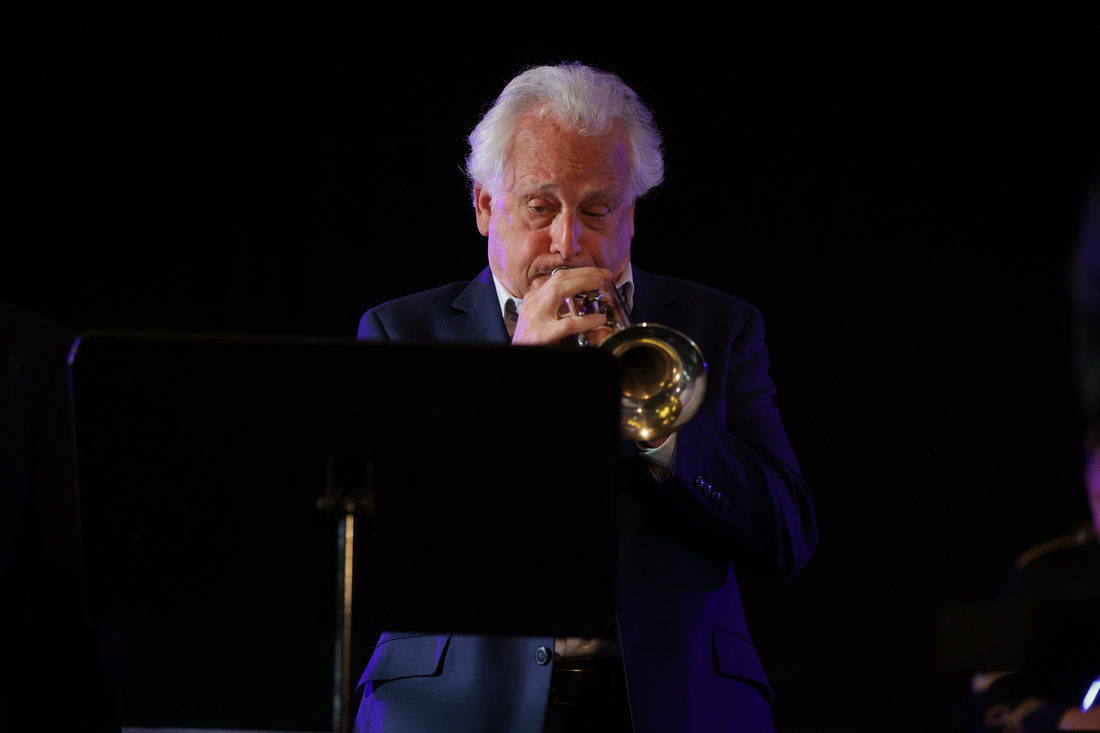

Open jam session - Eric Siereveld
Dr. Eric Siereveld led this second late-night jam session that included Mike Frank on piano, Peter Paulson on bass, and Larry Marshall on drums and included over twenty other attendees and guest artists. The trio opened with a tune featuring Siereveld. While they were playing, attendees signed up to play a tune on which they wanted to solo. Throughout the night, Siereveld invited two to five of the attendees to play at a time, and by midnight they had played a number tunes that included Stella by Starlight, A Night in Tunisia, Watermelon Man, It Could Happen to You, and What is this Thing Called Love. The session ended with a bang as seven of the attendees and guest artists played Sandu. (Spencer Brand)
Click here for more photos from the ITG Conference